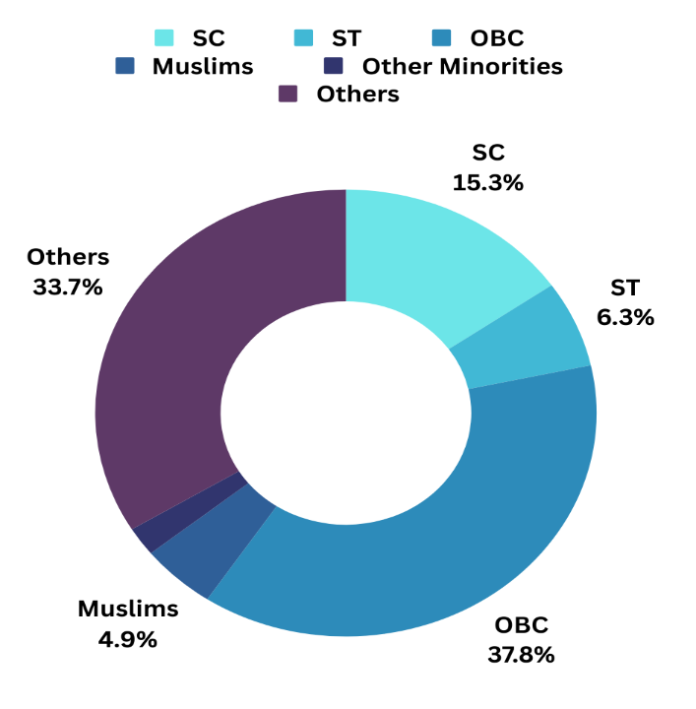– Sadat Hussain
The release of 12th edition of All India Survey for Higher Education Report 2021-22 by the Ministry of Education, Government of India, on Thursday, has added one more chapter to the massive expansion of higher education in the Indian higher education system.
The report says that under the Indian higher education system, there is a 4.6 percent increment in the enrollment from 2020-21. As per the report, the Indian higher education system currently has 4.33 crore students, 1,168 universities/ university-level institutions, 45,473 colleges, and 12,002 stand-alone institutions.
Though the enrolment of Muslims has increased by 9.7 percent, from 19.22 lakh students to 21.1 lakh, their share among all other social groups is just 4.87 percent of the total enrollment, which is comparatively lower than SC (15.3 percent), ST (6.3 percent), OBC (37.8 percent) and Others 33.7 (percent). The ‘Others’ category includes EWS, Generals (Other than EWS), PWD (Persons with Disables), and Foreign nationals.

Source: AISHE Annual Report 2021-22
Collecting data under the All-India Survey for Higher Education (AISHE) started in 2011. The report collects the data with regards to several parameters such as “teachers, student enrolment, programmes, examination results, infrastructure, etc. are being collected and indicators of educational development such as Institution Density, Gross Enrolment Ratio, Pupil-Teacher Ratio, Gender Parity Index, etc.”
The last report of AISHE 2020-21 had become a matter of discussion due to the low enrollment of Muslims in higher education. The enrolment of Muslims had declined during the previous year from 21 lakhs in 2019-20 to 19.22 lakhs in 2020-21. In the last five years, Muslim enrollment has been slow and gradual. Except for 2020-21, there has been growth year after year. During 2017-18, the enrollment of Muslims was 18.38 lakhs, which increased by 12.8 percent in the last five years. The slow and gradual increase in the enrollments of Muslims can be observed in the graph below:

Source: AISHE Annual Reports
The above graph concerns the enrollment of Muslims in higher education from 2017-18 to 2021-22. The graph shows that the total enrolment curve is flat and gradually increasing trend. The graph also shows that the gender gap among Muslim students in higher education is marginal. Though the participation of Muslims in higher education is a gradual and slowly increasing trend, their participation in comparison with other social groups is a matter of concern.
| Social group-wise percentage of total enrolment | |||||||
| SC | ST | OBC | Muslims | OM | Others | Total | |
| 2012-13 | 12.80 | 4.40 | 31.20 | 4.20 | 1.90 | 45.50 | 100.00 |
| 2013-14 | 13.10 | 4.60 | 32.40 | 4.30 | 2.00 | 43.60 | 100.00 |
| 2014-15 | 13.44 | 4.80 | 32.80 | 4.50 | 1.90 | 42.56 | 100.00 |
| 2015-16 | 13.90 | 4.90 | 33.75 | 4.70 | 1.97 | 40.78 | 100.00 |
| 2016-17 | 14.20 | 5.10 | 34.40 | 4.90 | 2.20 | 39.20 | 100.00 |
| 2017-18 | 14.40 | 5.20 | 35.00 | 5.00 | 2.20 | 38.20 | 100.00 |
| 2018-19 | 14.90 | 5.50 | 36.30 | 5.20 | 2.30 | 35.80 | 100.00 |
| 2019-20 | 14.70 | 5.60 | 37.00 | 5.50 | 2.30 | 34.90 | 100.00 |
| 2020-21 | 14.20 | 5.80 | 35.80 | 4.60 | 2.00 | 37.60 | 100.00 |
| 2021-22 | 15.31 | 6.26 | 37.76 | 4.87 | 2.09 | 33.71 | 100.00 |
Source: All India Survey for Higher Education Reports
The above table documents the social group-wise percentage of total enrolment. Over the years from 2012-13 to 2021-22, as per AISHE Annual reports, the share of Muslims in higher education has been consistently lower than SC, ST, OBC and Others.
The participation of Muslims in higher education is consistently low. The latest education round of the National Sample Survey Organization (75th round 2017-18) also suggests that Muslims have the lowest Gross Attendance Ratio in higher education, similarly, as per Prof. Arun C Mehta’s report “State of Muslim Education in India-2021” Muslims have only 8.9 Gross Enrolment Rates. The Sachar Committee 2006 and NSSO reports cite various reasons for this backwardness. Poverty, lack of parents’ interest and lack of children’s disinterest in education are prominent reasons cited for the backwardness.




